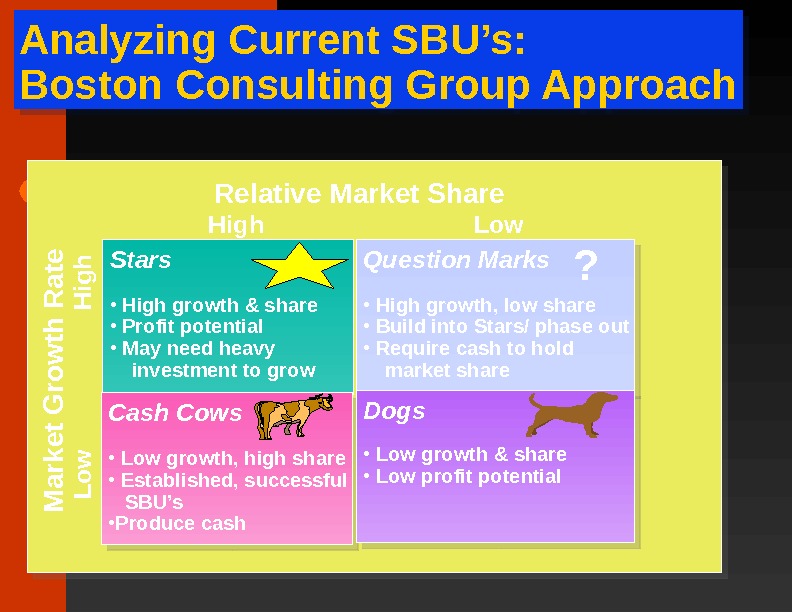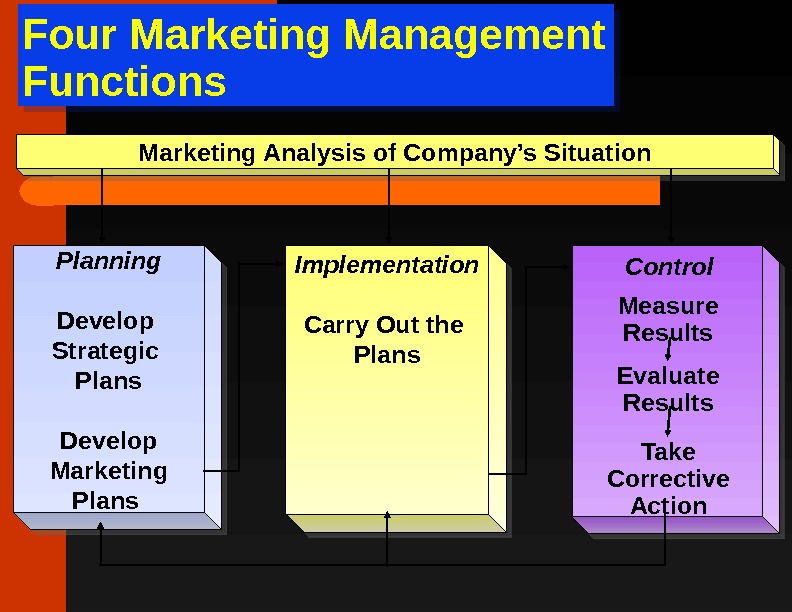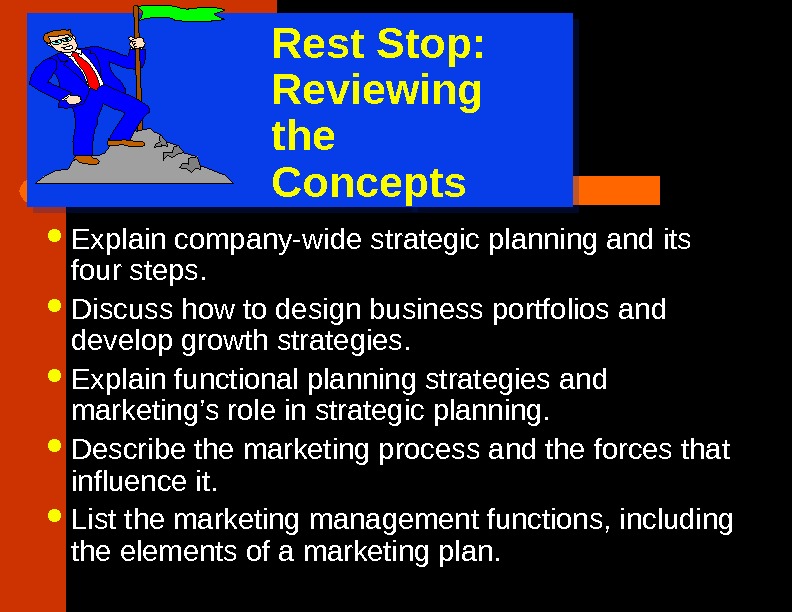Strategic Planning and the Marketing Process Strategic






















marketing_management_strategic_plan.ppt
- Размер: 489 Кб
- Количество слайдов: 21
Описание презентации Strategic Planning and the Marketing Process Strategic по слайдам
 Strategic Planning and the Marketing Process
Strategic Planning and the Marketing Process
 Strategic Planning Process Strategic Planning is the process of developing and maintaining a strategic fit between the organization’s goals and capabilities and its changing marketing opportunities. This process involves: – Defining the Company Mission : Statement of an organization’s purpose — what it wants to accomplish in the larger environment. – Setting Company Objectives and Goals : Supporting objectives for each level of management. – Designing the Business Portfolio : Collection of businesses and products that make up the company. – Planning Functional Strategies : Detailed planning for each department designed to accomplish strategic objectives.
Strategic Planning Process Strategic Planning is the process of developing and maintaining a strategic fit between the organization’s goals and capabilities and its changing marketing opportunities. This process involves: – Defining the Company Mission : Statement of an organization’s purpose — what it wants to accomplish in the larger environment. – Setting Company Objectives and Goals : Supporting objectives for each level of management. – Designing the Business Portfolio : Collection of businesses and products that make up the company. – Planning Functional Strategies : Detailed planning for each department designed to accomplish strategic objectives.
 Copyright 1998 Prentice Hall 2 -3 Market Oriented Fit Market Environment Motivating. Realistic Distinctive Competencies Specific Characteristics of Good Mission Statements
Copyright 1998 Prentice Hall 2 -3 Market Oriented Fit Market Environment Motivating. Realistic Distinctive Competencies Specific Characteristics of Good Mission Statements
 Designing the Business Portfolio “ The best portfolio is the one that best fits the company’s strengths and weaknesses to opportunitiesintheenvironment. ” A Strategic Business Unit (SBU) is a unit of the company: – that has a separate mission and objectives, and – that can be planned independently from other company businesses. The company must: – analyze its current business portfolio or Strategic Business Units (SBU’s), and – decide which SBU’s should receive more, less, or no investment, and – develop growth strategies for adding new products or businesses to the portfolio.
Designing the Business Portfolio “ The best portfolio is the one that best fits the company’s strengths and weaknesses to opportunitiesintheenvironment. ” A Strategic Business Unit (SBU) is a unit of the company: – that has a separate mission and objectives, and – that can be planned independently from other company businesses. The company must: – analyze its current business portfolio or Strategic Business Units (SBU’s), and – decide which SBU’s should receive more, less, or no investment, and – develop growth strategies for adding new products or businesses to the portfolio.
 Analyzing Current SBU’s: Boston Consulting Group Approach Question Marks • High growth, low share • Build into Stars/ phase out • Require cash to hold market share. Stars • High growth & share • Profit potential • May need heavy investment to grow Cash Cows • Low growth, high share • Established, successful SBU’s • Produce cash Dogs • Low growth & share • Low profit potential Relative Market Share High Low. M a r k e t G r o w th R a te L o w H ig h ?
Analyzing Current SBU’s: Boston Consulting Group Approach Question Marks • High growth, low share • Build into Stars/ phase out • Require cash to hold market share. Stars • High growth & share • Profit potential • May need heavy investment to grow Cash Cows • Low growth, high share • Established, successful SBU’s • Produce cash Dogs • Low growth & share • Low profit potential Relative Market Share High Low. M a r k e t G r o w th R a te L o w H ig h ?
 Can be Difficult, Time-Consuming, & Costly to Implement Difficult to Define SBU’s & Measure Market Share/ Growth Focus on Current Businesses, But Not future Planning Can Lead to Unwise Expansion or Diversification Problems With Matrix Approaches
Can be Difficult, Time-Consuming, & Costly to Implement Difficult to Define SBU’s & Measure Market Share/ Growth Focus on Current Businesses, But Not future Planning Can Lead to Unwise Expansion or Diversification Problems With Matrix Approaches
 Developing Growth Strategies 1. Market Penetration 2. Market Development 3. Product Development 4. Diversification Existing Markets New Markets Existing Products New Products. Product/ Market Expansion Grid
Developing Growth Strategies 1. Market Penetration 2. Market Development 3. Product Development 4. Diversification Existing Markets New Markets Existing Products New Products. Product/ Market Expansion Grid
 Product/ Market Expansion Grid Market Penetration : making more sales to current customers without changing products. How? Cut prices, increase advertising, get products into more stores. Market Development : identifying and developing new markets for its current products. How? Identify new demographic or geographic markets. Product Development : offering modified or new products to current markets. How? New styles, sizes, colors, or other modified products. Diversification : start up or buy new businesses outside of its current products and markets.
Product/ Market Expansion Grid Market Penetration : making more sales to current customers without changing products. How? Cut prices, increase advertising, get products into more stores. Market Development : identifying and developing new markets for its current products. How? Identify new demographic or geographic markets. Product Development : offering modified or new products to current markets. How? New styles, sizes, colors, or other modified products. Diversification : start up or buy new businesses outside of its current products and markets.
 Marketing’s Role in Strategic Planning Provides a Guiding Philosophy Provides Inputs to Strategic Planners Designs Strategies for Reaching Unit’s Objectives
Marketing’s Role in Strategic Planning Provides a Guiding Philosophy Provides Inputs to Strategic Planners Designs Strategies for Reaching Unit’s Objectives
 A Company’s Value Chain Customer Purchasing Operations Marketing Information Systems. Each Department in a Company Carries Out Value-Creating Activities to Design, Produce, Market, Deliver, and Support the Firm’s Products.
A Company’s Value Chain Customer Purchasing Operations Marketing Information Systems. Each Department in a Company Carries Out Value-Creating Activities to Design, Produce, Market, Deliver, and Support the Firm’s Products.
 Speed Bump: Linking the Concepts • What does Strategic Planning have to do with marketing? • What are Levi Strauss & Co. ’s mission and strategy? • What roles do other functional departments play? • How can Levi Strauss’s marketers work more effectively with these other functions to maximize overall customer value?
Speed Bump: Linking the Concepts • What does Strategic Planning have to do with marketing? • What are Levi Strauss & Co. ’s mission and strategy? • What roles do other functional departments play? • How can Levi Strauss’s marketers work more effectively with these other functions to maximize overall customer value?
 The Marketing Process Target Consumers Product Place Price Promotion. M arketing Im plem entation Marketing Planning M arketing Control Marketing Analysis Competitors Marketing Intermediaries Publics. Suppliers Demographic- Economic Environment Technological- Natural Environment Political- Legal Environment Social- Cultural Environment
The Marketing Process Target Consumers Product Place Price Promotion. M arketing Im plem entation Marketing Planning M arketing Control Marketing Analysis Competitors Marketing Intermediaries Publics. Suppliers Demographic- Economic Environment Technological- Natural Environment Political- Legal Environment Social- Cultural Environment
 Process of Selecting Target Consumers • Market Segmentation : process of dividing a market into distinct groups buyers (segments) with different needs, etc. who might require separate products. • Market Segment — consumers who respond in similar way to a given set of marketing efforts. • Market Targeting : evaluating each market segment’s attractiveness and selecting one or more target segments to enter. • Market Positioning : products clear, distinctive and desirable place relative to competing products in the minds of target segments.
Process of Selecting Target Consumers • Market Segmentation : process of dividing a market into distinct groups buyers (segments) with different needs, etc. who might require separate products. • Market Segment — consumers who respond in similar way to a given set of marketing efforts. • Market Targeting : evaluating each market segment’s attractiveness and selecting one or more target segments to enter. • Market Positioning : products clear, distinctive and desirable place relative to competing products in the minds of target segments.
 Marketing Mix- The Four P’s Target Customers Intended Positioning. Product Goods-and-service combination a company offers a target market Amount of money consumers have to pay to obtain the product Activities that persuade target customers to buy the product Company activities that make the product available to target customers Price Promotion Place
Marketing Mix- The Four P’s Target Customers Intended Positioning. Product Goods-and-service combination a company offers a target market Amount of money consumers have to pay to obtain the product Activities that persuade target customers to buy the product Company activities that make the product available to target customers Price Promotion Place
 Four Marketing Management Functions Planning Develop Strategic Plans Develop Marketing Plans Implementation Carry Out the Plans Marketing Analysis of Company’s Situation Control Measure Results Evaluate Results Take Corrective Action
Four Marketing Management Functions Planning Develop Strategic Plans Develop Marketing Plans Implementation Carry Out the Plans Marketing Analysis of Company’s Situation Control Measure Results Evaluate Results Take Corrective Action
 Contents of a Marketing Plan. Executive Summary Current Marketing Situation Threats and Opportunities Objectives and Issues Marketing Strategy Action Programs Budgets Controls
Contents of a Marketing Plan. Executive Summary Current Marketing Situation Threats and Opportunities Objectives and Issues Marketing Strategy Action Programs Budgets Controls
 Marketing Implementation. Marketing Strategy Marketing Performance Implementation Climate and Culture. Action Programs Decision and Reward. Organizational Structure Human Resources
Marketing Implementation. Marketing Strategy Marketing Performance Implementation Climate and Culture. Action Programs Decision and Reward. Organizational Structure Human Resources
 Marketing Department Organization Market Management. Combination Plan Product Management Geographic. Functional Ways to Carry Out Marketing Activities
Marketing Department Organization Market Management. Combination Plan Product Management Geographic. Functional Ways to Carry Out Marketing Activities
 Marketing Control. Set Marketing Goals Measure Performance Evaluate Performance Take Corrective Action
Marketing Control. Set Marketing Goals Measure Performance Evaluate Performance Take Corrective Action
 Marketing Audits Marketing Organization. Marketing Environment Marketing Systems Marketing Strategy Areas of Assessment in Marketing Audits. Marketing Productivity & Profitability Marketing Mix
Marketing Audits Marketing Organization. Marketing Environment Marketing Systems Marketing Strategy Areas of Assessment in Marketing Audits. Marketing Productivity & Profitability Marketing Mix
 Rest Stop: Reviewing the Concepts Explain company-wide strategic planning and its four steps. Discuss how to design business portfolios and develop growth strategies. Explain functional planning strategies and marketing’s role in strategic planning. Describe the marketing process and the forces that influence it. List the marketing management functions, including the elements of a marketing plan.
Rest Stop: Reviewing the Concepts Explain company-wide strategic planning and its four steps. Discuss how to design business portfolios and develop growth strategies. Explain functional planning strategies and marketing’s role in strategic planning. Describe the marketing process and the forces that influence it. List the marketing management functions, including the elements of a marketing plan.

